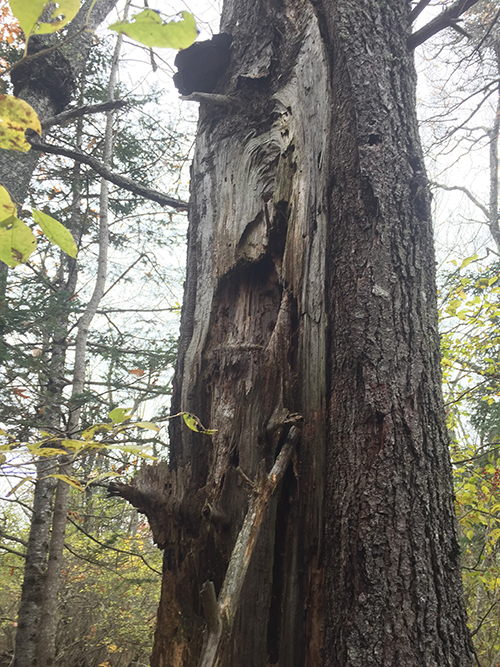 |
| Large diameter cavity trees provide bird habitat, enhancing the overall value of a forest. English photo |
By Noah Gleason-Hart
When the topic of forestry or land management comes up, the first question people often ask is, “Should I my cut my woodlot?” or, “Is my land due for a harvest?” It’s a daunting question with huge implications. Perhaps it would be better to ask, “What are my goals for my woodlot, and can harvesting help me reach those goals?”
When done correctly, harvesting is not a withdrawal from a bank account; it is a tool to shape the composition and structure of the forest environment to meet management objectives. Your management objective may be to increase the financial value of your woodlot over time without causing environmental degradation. As committed landowners, we are often encouraged to view harvests in this way. However, I would challenge you to consider the harvesting not just as a means to improve timber quality but as a broader ecosystem management tool. A carefully planned harvest carried out by a skilled, conscientious logger or a dedicated landowner can lead to some surprising outcomes.
Restoring Old Growth Forest Characteristics
After centuries of logging and agriculture, old growth forests represent 0.1 percent of our wooded land. Although we can’t create new old growth, researchers have identified four characteristics of these stands that we can replicate in our woods to serve some of the ecosystem functions of true old growth: diverse age structures, including very large trees, gaps in the forest canopy, and significant numbers of standing snags and dead and down logs. Through judicious logging, we can increase the rate at which our woods take on these characteristics. Thinning to favor long-lived species with strong crowns can increase growth rates and reduce the time required to grow large-diameter trees that will never be cut. Harvesting trees in groups up to one-quarter of an acre in size can create canopy gaps, and girdling large cull trees and felling and leaving other trees can increase the percentage of standing and down dead wood in the stand.
Enhancing Bird and Wildlife Habitat
New England’s privately owned forests are uniformly middle-aged and lack well developed lower and mid-story structure necessary for robust bird populations. A harvest can jumpstart this diversity by using canopy openings to create forest with a variety of different age classes, heights, species and food sources.
As landowners we can also expand our definition of “save” or “crop trees” to favor large diameter cavity trees that provide bird habitat or those that produce soft mast, such as black cherry or apple.
Increase Forest Resilience to Climate Change
Finally, harvesting can help us shape a forest that is more resilient to impending changes in the climate. In the process of selecting which trees to cut, a landowner, or the landowner’s forester, can increase species and age diversity and decrease the likelihood that a single event would catastrophically impact the integrity of the forest. For example, if a lot is expected to be affected by emerald ash borer in the next five to 10 years, a harvest could be conducted to reduce the amount of ash on the property and set up conditions for different species to regenerate, while still maintaining some ash as a genetic reservoir. (For more on the emerald ash borer, please see our low-impact forestry column “10 Q&A’s About Emerald Ash Borer” in the spring 2019 issue of The Maine Organic Farmer & Gardener.)
Good Reasons Not to Harvest
There are still good reasons to never carry out a harvest. Untouched reserves are rare in the Northeast, and from a biological diversity perspective, efforts to establish them for the long term should be supported. From a carbon perspective, unmanaged lands are valuable in their ability to accumulate biomass and store maximum carbon. Thankfully this is not a zero-sum game – we can adopt both strategies by designating some stands to be left uncut within our own woodlot and by creating a mosaic of actively and passively managed properties on the landscape level. There is room for both approaches in our woods and in the low-impact forestry community.
So, should you conduct a harvest in your woods? The choice is yours, but if you decide – as I have – to use harvesting as a tool in parts of the woodlots you own or manage, be intentional and well-informed. Once you cut trees down, they’re tough to put back up.
Here are some resources for more information on how careful harvesting can help you meet different management goals.
Restoring Old Growth Characteristics
Forest Carbon: An essential natural solution to climate change
Crop Tree Management in Eastern Hardwoods
Patient Money: The Economics of Low Impact Forestry, from Low Impact Forestry by Mitch Lansky
Noah Gleason-Hart is MOFGA’s low-impact forestry specialist. You can reach him at [email protected].
